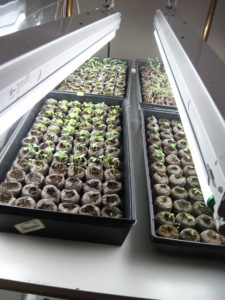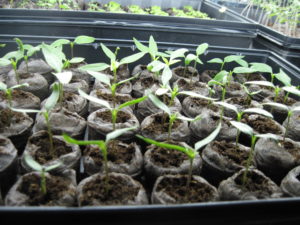Catch the Seed Starting Bug!
- 2019-04-10
- By danibash
- Posted in The Garden Buzz
Few springtime garden activities are as satisfying as starting seeds. Start seeds for fun, to save money, to grow varieties that can’t be found at local garden centers or to sell or give away. Friends and neighbors will likely delight in a gift of plants for their gardens. Supplies are abundant in the spring in garden centers, big box stores or online.
If you are a beginner, choose a few varieties and start simple for success, increasing each year as you gain experience. Some popular seeds to start are tomato, pepper, eggplant, onion, squash, cucumber, melon, cabbage, cauliflower, broccoli, herbs and flowers.

There are a few basic supplies you will need. Flats with cells containing peat pellets that soften when water is added make seed starting a snap. Choose flats with or without cells, used pots from the garden shed or even used containers like yogurt cups with holes punched in the bottom for drainage. Use a soiless seed starting mix for flats without peat pellets or pots. To avoid disease never use garden soil. Disinfect used pots with a 10% bleach solution to eliminate any pathogens. All flats or pots need a clear plastic covering to retain moisture during germination.
A sunny windowsill does not provide enough light so use seed starting lights (T-5 or T-8) or standard fluorescent tubes (T-12). For fluorescents, one cool tube and one warm tube will cover the light spectrum required.

Heat mats are optional for speeding up germination or flats can be placed on top of a refrigerator for warmth.
The proper time to begin depends on the variety. Most seeds can be started four to six weeks before the last frost date. Check dates on the envelope and count backward from the last average frost free date. In the Denver Metro area that date is around mid May.
Wash hands and tools before beginning. Plant seeds as indicated on the packet and label if starting more than one variety, lightly mist and cover. Place in a warm location until germination. Once seedlings emerge, use supplemental lighting. Provide lighting no less than 12 hours or no more than16 hours per day. To avoid disease water only from the bottom. A small house fan blowing over the surface of the soil helps to build strong stems and strengthens the seedlings against damping off, a fatal soil-borne fungus that attacks at the soil level.
After the second set of leaves appears, they may soon outgrow their space and need to be transplanted into bigger pots. Use good quality potting soil and water with half-strength fertilizer solution.
The most common causes of seedling failure are insufficient light, too much or not enough water. Keep the soil evenly moist, provide adequate light and avoid temperature fluctuations that stress young plants and make them susceptible to disease.

Introduce tender plants to the outdoors gradually after being in a protected environment. Start by placing them in dappled shade for about an hour. Gradually increase both time outside and exposure to full sun. Harden them off by leaving them out overnight only if the minimum temperature is well above 40 degrees. Monitor moisture levels and don’t forget to take notes for next year!
Article written by Paula Szilard
Horticulture Resources
- Garden Buzz Archives
- CSU Extension Resources
- Colorado Master Gardener Program
- Foothills to Plains Native Plant Master Program
- Native Bee Watch Community Science Program
- The Co-Hort Blog
- PlantTalk Colorado
- Soil Testing
- Plant Select
- Emerald Ash Borer
- Japanese Beetle
- Colorado State Forest Service
- Ask an Expert


